教师资格考试(初中)英语学科2017下
2017下半年教师资格考试初中英语面试真题
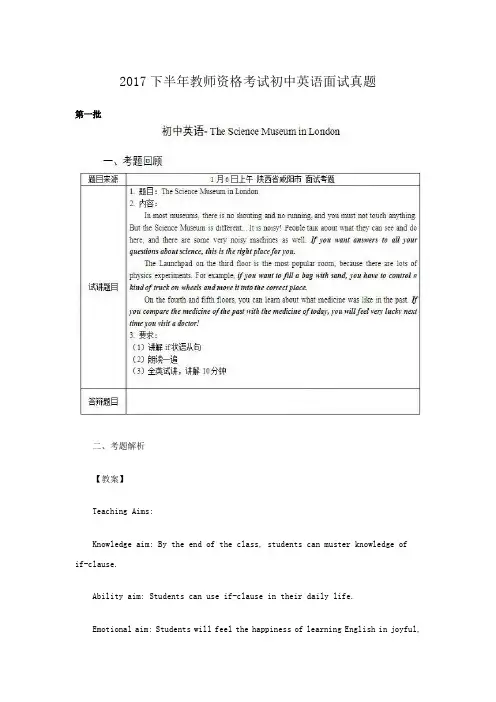
2017下半年教师资格考试初中英语面试真题第一批二、考题解析【教案】Teaching Aims:Knowledge aim: By the end of the class, students can muster knowledge ofif-clause.Ability aim: Students can use if-clause in their daily life.Emotional aim: Students will feel the happiness of learning English in joyful,free and open atmosphere, and will be confident to express in English.Teaching Key Points:Students can know the structure, function and tense of if-clause.Teaching Difficult Point:Students can put the new knowledge into practice.Teaching Methods:Tasked-based Teaching Method, Communicative Approach.Teaching Aids:The blackboardTeaching Procedures:Step 1: Lead-inGreeting with the students.Sing a song for students- if you are happy. Ask them “Did you hear the word-if”to lead in the class.Step 2: PresentationLet the students read the passage and find out sentences with “if”. Then teacher will ask students write these sentences on the blackboard. Then find out the similarities among these sentences.According to the answers from students, teacher make a brief summary:1.If-clause means condition and the main clause is the result. 2. The main clause and if-clause have the same tense. However, if it describes things in the future, the main clause uses the Simple Future Tense and if-clause use the Simple Present Tense.Step 3: PracticeRead the sentences by themselves and practice with neighbors.Step 4: ProductionUse the sentence and structure what we learned today to make a conversation with your neighbor and invite some students performance it.Step 5: Summary and homeworkSummary: Sum up what we have learned today.Homework: After class, teach these sentences to their parents.Blackboard Design:二、考题解析【教案】Teaching AimsKnowledge aim:Students can understand this short passage and master some expressions about comparative degree.Ability aim:Students will improve their reading efficiency and reading ability.Emotional aimStudents are willing to read a lot of English reading materials in their daily life.Teaching Key &Difficult PointsKey point: Students can understand comparative degree.Difficult point: foster good habit of reading English materials in their daily life.Teaching procedures:Step 1: Warming upShow two pictures of twins, encourage students to describe them in their own words and then share their answer with each other.Step 2: PresentationRead the short passage for the first time and they need to read it as fast as the can, ask them what is the main idea of this passage and students share answers.Students read the passage for the second time and ask them some more questions and ask them to pay attention to the comparative degree.Step 3: PracticeGive students some adjective or adverbial words, and ask them to write down the comparative form of these words, the one who writes most without mistakes will get a present.Step 4: ProductionStudents work in groups to describe a person with comparative degree, teacher will give them 8 minutes to prepare it and 8 minutes later, invite some students to be the story teller to introduce his or her friends.Step 5: Summary & HomeworkStudents look at the blackboard and retell the short passage to summarize this class, and the homework is that students introduce Jenny and Nancy to their friends or parents.Blackboard design第二批二、考题解析【教案】Teaching aims:Knowledge aim:Students will master the expression of date and the sentence structure: -What is ...’s birthday? -It is ...Ability aim:Students will improve their abilities of speaking and listening.Emotional aim:Students will be more confident in speaking English.Key and difficult point:Key Point: Students will master how to express a date in English.Difficult Point: Students will use the sentence structure in daily life.Teaching procedure:Step 1: Warming-up1. Greetings.2. Ask students if today is anyone’s birthday. And invite the whole class to sing a ‘Happy Birthday’ song to him or her.Step 2: Pre-listening1. Review the knowledge about ordinal numeral: write some numbers on the blackboard and ask students to change the cardinal numeral into ordinal numeral.2. Ask students to look at the picture in the textbook to predict what the dialogue may be about.Step 3: While-listening二、考题解析【教案】Teaching aims:Knowledge aim: students will know the topic of “you are never too young to start doing things that you don’t know how to do before”.Ability aim: students can increase the speaking ability through talking the topic.Emotional aim: students will develop their awareness of starting doing things as soon as possible.Key and difficult point:Key point: students can increase the speaking ability through talking the topic.Difficult point: students will develop their awareness of starting doing things as soon as possible.Teaching procedure:Step 1: Warming-upGreet the students.Show several pictures of the famous golf player Tiger Woods, the musician Mozart, and the great Brazilian soccer player Ronaldo when they are young, and let students guess who they are, then the teacher tells students that they started doing theirinterest in a young age. Then lead the topic of the class.Step 2: Pre-speakingFirstly, read the passage then conclude and make clear the topic of the speaking class— you are never too young to start doing things that you don’t know to do before. Secondly, the teacher gives several aspects of the topic, including what the event is they have experienced in a young age, when they started doing it, how they did it and what achievements they have got through it. Thirdly, the teacher gives an example. students talk about topic at several aspects above in groups.Step 3: While-speaking1. One student ask the questions about the topic at every single aspect above, the other student answer, then exchange.2. Students talk about the topic at several aspects above to their partners.3. Survey and report. One student makes a survey about the event in a young age of other group members, and take down notes.Step4: Post-speaking1. self—report: talk about the event that they started doing in a young age.2. peer—report: ask some students in different groups to have a repot of other students’ events in a young age.Step 5: Summary and HomeworkTell students we should start doing things as soon as possible.Homework: students think about more events they’d like to start.Blackboard design:二、考题解析【教案】Teaching aims:Knowledge aim: Students will master the sentence pattern “can you” and some new words such as sing, play the piano and so on.Ability aim: Students will improve their speaking ability through group work.Emotional aim: Students will take part in the class actively and be fond of learning English.Key and difficult point: Students can master the sentence pattern and words and can take part into the class actively.Teaching procedure:Step 1: Warming-upGreeting: Good morning boys and girls, this is your beloved English teacher, Jessica. How are you today? Fine, I'm too. It is snowing right now right? The weather is getting colder and colder, so put on more clothes and don't catch cold ok? Otherwise you will lag behind for your English studying.Lead-in: 展示有关音乐会的图片:Sydney Opera House/ National opera house in Beijing1)what can you see in the pictures2) Where can we do in it?3) Do you like to enjoy a music show in our school?4) Let’s take a look of today’s class: musicians wanted for school music festival.Step 2: Pre-reading图片讲解单词:sing/ dance/ play the piano/1) What can you see in the pictures: 依次展示TF boys/ ballet/ 朗朗2) What is he/ she doing in the picture? 依次引出: sing/ dance/ play the piano.3) When you sing, you make musical sounds with your voice, usually producing words that fit a tune.4) When you dance, you move your body and feet in a way that follows a rhythm, usually in time to music.5) A piano is a large musical instrument with a row of black and white keys. When you press these keys with your fingers, little hammers hit wire strings inside the piano, which vibrate to produce musical notes.Step 3: While-reading设置阅读问题:1) Which musical instruments are mentioned in the passage:The piano (Y), the trumpet (Y), the drums (Y). violin (X).2) who should you contact if you are interested: zhang heng3) The telephone number? 622-6033.Step4: Post-reading1) Do a survey: which musical instruments can your classmate play?2) Making a conversation by using the result of the survey: Do you want to go to the music festival?Blackboard design:。
[职业资格类试卷]2017年下半年中学教师资格认定考试(初级英语学科知识与教学能力)真题试卷.doc
![[职业资格类试卷]2017年下半年中学教师资格认定考试(初级英语学科知识与教学能力)真题试卷.doc](https://uimg.taocdn.com/ad0b4c5e915f804d2a16c13a.webp)
[职业资格类试卷]2017年下半年中学教师资格认定考试(初级英语学科知识与教学能力)真题试卷一、单项选择题1 The main difference between /e/ and // lies in the______.(A)tongue position(B)sound duration(C)openness of the mouth(D)shape of the lips2 _____ is the main rhyming pattern in "Mrs. White/Had a fright/In the middle of the night".(A)Assonance(B)End rhyme(C)Alliteration(D)Reverse end rhyme3 We're all keeping our______crossed that the surgeons do not find anything too serious with the patient.(A)fingers(B)thumbs(C)hands(D)feet4 When implementing the project, we______ a lot of unexpected opposition from our colleagues.(A)run for(B)make against(C)run up against(D)make away with5 The island measures about 30 miles______20 miles.(A)by(B)with(C)to(D)upon6 —Will John come to the party? —No, he won't come and______.(A)Antony neither won' t(B)won't Antony neither(C)either will Antony(D)neither will Antony7 Garbo plays the role of the queen,______ in the love she has found with Antonio. (A)rejoiced(B)rejoicing(C)being rejoiced(D)to rejoice8 _____ ministers decide to instigate an inquiry, we______welcome it.(A)Should ... would(B)Suppose ... could(C)If... would(D)Would ... will9 What is missing at the discourse level between the two sentences "Carol loves tomatoes. She was born in Africa."?(A)Reference.(B)Cohesion.(C)Coherence.(D)Substitution.10 The synonyms "charge" and "accuse" mainly differ in______.(A)emotion(B)dialect(C)formality(D)collocation11 Which of the following instructions is helpful in developing students' ability to make inferences?(A)Listen to a story and write a summary.(B)Listen to a story and work out the writer's intention.(C)Listen to the story of a boy and then draw a picture of him.(D)Listen to a story and note down the specific date of an event.12 The most suitable question type to check students' comprehension and develop their critical thinking is______.(A)rhetorical questions(B)referential questions(C)close questions(D)display questions13 Diagnostic test is often used for the purpose of(A)finding out what students know and don't know(B)measuring students' general language proficiency(C)knowing whether students have the right language aptitude(D)checking whether students have achieved the teaching objectives14 Which of the following activities is often used to develop students' speaking accuracy? (A)Identifying and correcting oral mistakes.(B)Acting out the dialogue in the text.(C)Having discussions in groups.(D)Describing people in pair.15 If a teacher asks students to make their own learning plan, he/she is trying to develop their______.(A)cognitive strategy(B)affective strategy(C)communicative strategy(D)metacognitive strategy16 When a teacher tells students that the word "dog" may imply "loyalty", he/she is teaching the______of the word.(A)denotative meaning(B)collocative meaning(C)conceptual meaning(D)connotative meaning17 Which of the following is the last step in the process of writing essays?(A)Editing the writings.(B)Writing topic sentences for paragraphs.(C)Gathering information and ideas relevant to the topic.(D)Organizing the information and ideas into a logical sequence.18 The main purpose of asking questions about the topic before listening is to______. (A)meet students' expectation(B)increase students' confidence(C)activate students' schemata(D)provide feedback on tasks19 If a teacher asks students to fill in the blanks in a passage with "that", "which" or "whom", he/she is least likely focusing on grammar at______.(A)lexical level(B)syntactic level(C)discourse level(D)morphological level20 If a teacher asks students to talk about their hobbies in groups, he/she is trying to encourage______.(A)peer correction(B)peer feedback(C)peer interaction(D)peer assessment二、简答题21 简述教材在英语教学中的两个作用,列出教师使用教材的三点注意事项。
2017下半年教师资格考试《初中英语学科》真题及答案
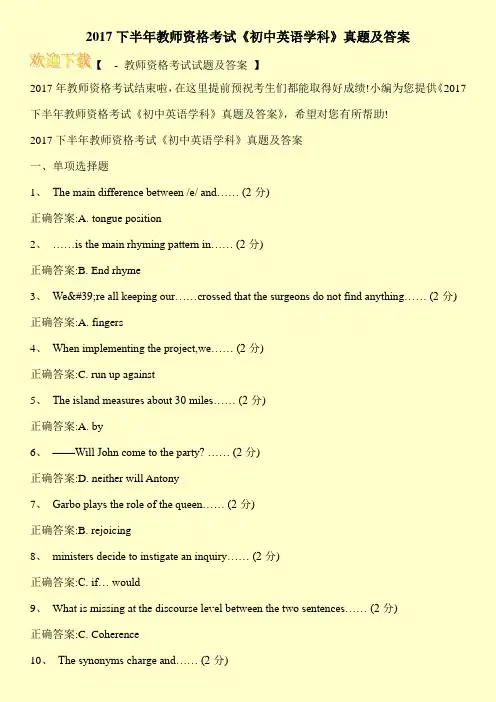
2017下半年教师资格考试《初中英语学科》真题及答案【- 教师资格考试试题及答案】2017年教师资格考试结束啦,在这里提前预祝考生们都能取得好成绩!小编为您提供《2017下半年教师资格考试《初中英语学科》真题及答案》,希望对您有所帮助!2017下半年教师资格考试《初中英语学科》真题及答案一、单项选择题1、The main difference between /e/ and…… (2分)正确答案:A. tongue position2、……is the main rhyming pattern in…… (2分)正确答案:B. End rhyme3、We're all keeping our……crossed that the surgeons do not find anything…… (2分) 正确答案:A. fingers4、When implementing the project,we…… (2分)正确答案:C. run up against5、The island measures about 30 miles…… (2分)正确答案:A. by6、——Will John come to the party? …… (2分)正确答案:D. neither will Antony7、Garbo plays the role of the queen…… (2分)正确答案:B. rejoicing8、ministers decide to instigate an inquiry…… (2分)正确答案:C. if… would9、What is missing at the discours e level between the two sentences…… (2分)正确答案:C. Coherence10、The synonyms charge and…… (2分)。
2017教师资格面试初中英语真题
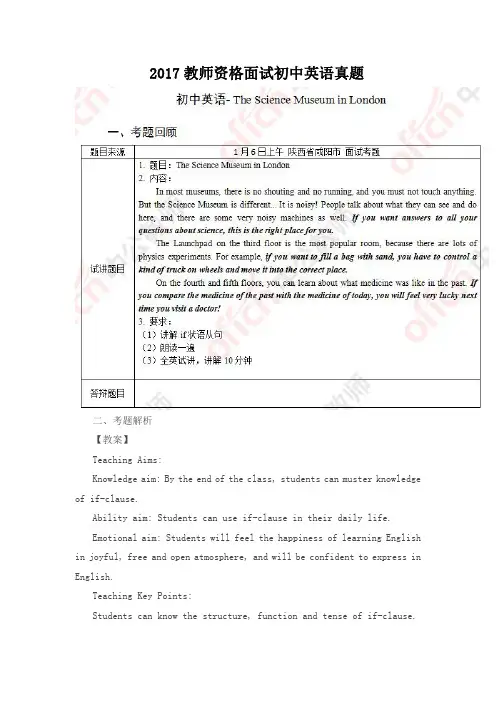
Students will improve their reading efficiency and reading ability. Emotional aim Students are willing to read a lot of English reading materials in their daily life. Teaching Key &Difficult Points Key point: Students can understand comparative degree. Difficult point: foster good habit of reading English materials in their daily life. Teaching procedures: Step 1: Warming up Show two pictures of twins, encourage students to describe them in their own words and then share their answer with each other. Step 2: Presentation Read the short passage for the first time and they need to read it as fast as the can, ask them what is the main idea of this passage and students share answers. Students read the passage for the second time and ask them some more questions and ask them to pay attention to the comparative degree. Step 3: Practice Give students some adjective or adverbial words, and ask them to write down the comparative form of these words, the one who writes most without mistakes will get a present. Step 4: Production Students work in groups to describe a person with comparative degree, teacher will give them 8 minutes to prepare it and 8 minutes later, invite some students to be the story teller to introduce his or her friends. Step 5: Summary & Homework Students look at the blackboard and retell the short passage to summarize this class, and the homework is that students introduce Jenny and Nancy to their friends or parents. Blackboard design
中小学教师资格考试《《英语学科知识与教学能力》(初级中学)
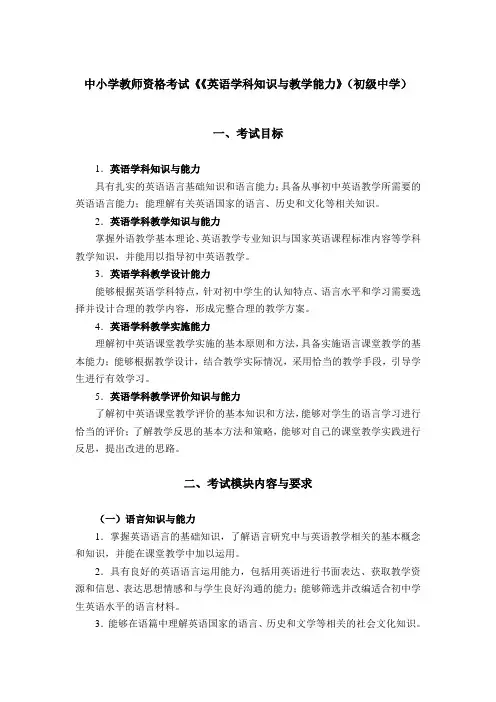
中小学教师资格考试《《英语学科知识与教学能力》(初级中学)一、考试目标1.英语学科知识与能力具有扎实的英语语言基础知识和语言能力;具备从事初中英语教学所需要的英语语言能力;能理解有关英语国家的语言、历史和文化等相关知识。
2.英语学科教学知识与能力掌握外语教学基本理论、英语教学专业知识与国家英语课程标准内容等学科教学知识,并能用以指导初中英语教学。
3.英语学科教学设计能力能够根据英语学科特点,针对初中学生的认知特点、语言水平和学习需要选择并设计合理的教学内容,形成完整合理的教学方案。
4.英语学科教学实施能力理解初中英语课堂教学实施的基本原则和方法,具备实施语言课堂教学的基本能力;能够根据教学设计,结合教学实际情况,采用恰当的教学手段,引导学生进行有效学习。
5.英语学科教学评价知识与能力了解初中英语课堂教学评价的基本知识和方法,能够对学生的语言学习进行恰当的评价;了解教学反思的基本方法和策略,能够对自己的课堂教学实践进行反思,提出改进的思路。
二、考试模块内容与要求(一)语言知识与能力1.掌握英语语言的基础知识,了解语言研究中与英语教学相关的基本概念和知识,并能在课堂教学中加以运用。
2.具有良好的英语语言运用能力,包括用英语进行书面表达、获取教学资源和信息、表达思想情感和与学生良好沟通的能力;能够筛选并改编适合初中学生英语水平的语言材料。
3.能够在语篇中理解英语国家的语言、历史和文学等相关的社会文化知识。
(二)语言教学知识与能力1.了解外语教学基本理论,理解语言观、语言学习观、语言教学观等对初中英语教学的指导作用。
2.理解《义务教育英语课程标准(2011年版)》的目标内容(语言技能、语言知识、情感态度、学习策略和文化意识),以及课程标准的其他相关知识,并能在教学设计与实施中运用。
3.掌握英语语言知识(语音、词汇、语法、语篇等)的教学基本原则、讲解和练习方法。
4.掌握英语语言技能(听、说、读、写)的教学原则和训练方法。
2017下半年初中英语教师资格证面试真题(精选)第二批(2)口语课
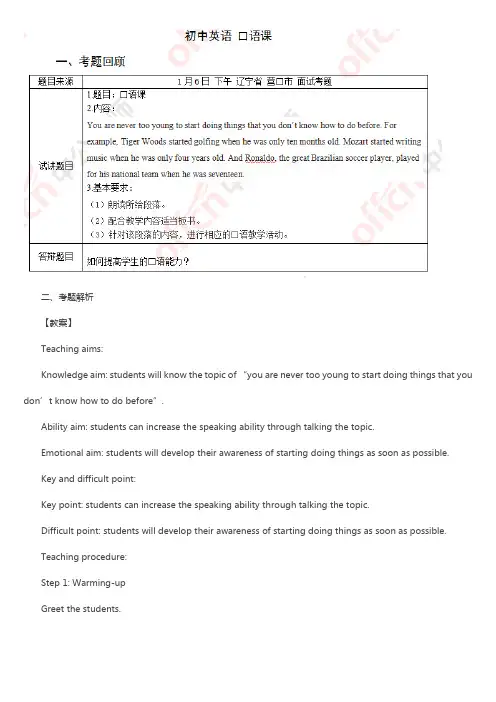
二、考题解析【教案】Teaching aims:Knowledge aim: students will know the topic of “you are never too young to start doing things that you don’t know how to do before”.Ability aim: students can increase the speaking ability through talking the topic.Emotional aim: students will develop their awareness of starting doing things as soon as possible.Key and difficult point:Key point: students can increase the speaking ability through talking the topic.Difficult point: students will develop their awareness of starting doing things as soon as possible.Teaching procedure:Step 1: Warming-upGreet the students.Show several pictures of the famous golf player Tiger Woods, the musician Mozart, and the great Brazilian soccer player Ronaldo when they are young, and let students guess who they are, then the teacher tells students that they started doing their interest in a young age. Then lead the topic of the class.Step 2: Pre-speakingFirstly, read the passage then conclude and make clear the topic of the speaking class—you are never too young to start doing things that you don’t know to do before. Secondly, the teacher gives several aspects of the topic, including what the event is they have experienced in a young age, when they started doing it, how they did it and what achievements they have got through it. Thirdly, the teacher gives an example. students talk about topic at several aspects above in groups.Step 3: While-speaking1. One student ask the questions about the topic at every single aspect above, the other student answer, then exchange.2. Students talk about the topic at several aspects above to their partners.3. Survey and report. One student makes a survey about the event in a young age of other group members, and take down notes.Step4: Post-speaking1. self—report: talk about the event that they started doing in a young age.2. peer—report: ask some students in different groups to have a repot of other students’events in a young age.Step 5: Summary and HomeworkTell students we should start doing things as soon as possible.Homework: students think about more events they’d like to start.Blackboard design:。
2017年下半年教师资格证考试初级英语真题解析答案
2017年下半年中小学教师资格考试英语学科知识与教学能力试题(初级中学)参考答案及解析一、单项选择题1.【答案】A。
解析:本题考查元音的发音。
根据发音时舌头在口腔中抬起的位置可分为:前元音、中元音、后元音。
根据发音时唇形的圆展可分为:圆唇元音和非圆唇元音。
根据元音的长度可分为:长元音和短元音。
根据以上分类方式,/e/可以描述为前、非圆唇、短元音,/ə/为中、非圆唇、短元音。
由此可知/e/和/ə/的主要区别为发音时舌的位置。
故本题选A。
2.【答案】B。
解析:本题考查修辞学。
Assonance“类韵”,指的是在诗歌中相同或相似元音的重复,它的目的主要是使句子悦耳动听或强调某个音。
例如:Slow the low gradual moan came in the snowing.End rhyme指“尾韵”,指词尾音素重复,如great和bait。
Alliteration“头韵”,指两个单词或两个单词以上的首字母相同,形成悦耳的读音。
例如:A Misty Morning May have a fine day.Reverse end rhyme“倒尾韵”,指重读音节中元音和辅音都相同,如will和wind。
根据题干可知句子中White,fright,night押的是尾韵。
故本题选B。
3.【答案】A。
解析:本题考查固定搭配。
Keep one’s fingers crossed的字面意思是将手指交叉起来,这个短语的比喻意义是“祈求好运”“希望一切如愿”“但愿别出差错”。
句意为“我们祈祷外科医生不会发现病人有太严重的疾病”。
4.【答案】C。
解析:本题考查动词短语辨析。
run for“竞选”,make against“不利于”,run up against“遇到,遭遇”,make away with“携……而逃,除去,杀死”。
句意为“当实施计划时,我们遭到同事们出人意料的反对”。
故本题选C。
5.【答案】A。
解析:本题考查介词by的用法。
教师资格全国统考《英语学科知识与教学能力》(初级中学)
教师资格全国统考《英语学科知识与教学能力》(初级中学)一、考试目标1.英语学科知识与能力具有扎实的英语语言基础知识和语言能力;具备从事初中英语教学所需要的英语语言能力;能理解有关英语国家的语言、历史和文化等相关知识。
2.英语学科教学知识与能力掌握外语教学基本理论、英语教学专业知识与国家英语课程标准内容等学科教学知识,并能用以指导初中英语教学。
3.英语学科教学设计能力能够根据英语学科特点,针对初中学生的认知特点、语言水平和学习需要选择并设计合理的教学内容,形成完整合理的教学方案。
4.英语学科教学实施能力理解初中英语课堂教学实施的基本原则和方法,具备实施语言课堂教学的基本能力;能够根据教学设计,结合教学实际情况,采用恰当的教学手段,引导学生进行有效学习。
5.英语学科教学评价知识与能力了解初中英语课堂教学评价的基本知识和方法,能够对学生的语言学习进行恰当的评价;了解教学反思的基本方法和策略,能够对自己的课堂教学实践进行反思,提出改进的思路。
二、考试模块内容与要求(一)语言知识与能力1.掌握英语语言的基础知识,了解语言研究中与英语教学相关的基本概念和知识,并能在课堂教学中加以运用。
2.具有良好的英语语言运用能力,包括用英语进行书面表达、获取教学资源和信息、表达思想情感和与学生良好沟通的能力;能够筛选并改编适合初中学生英语水平的语言材料。
3.能够在语篇中理解英语国家的语言、历史和文学等相关的社会文化知识。
(二)语言教学知识与能力1.了解外语教学基本理论,理解语言观、语言学习观、语言教学观等对初中英语教学的指导作用。
2.理解《义务教育英语课程标准(2011年版)》的目标内容(语言技能、语言知识、情感态度、学习策略和文化意识),以及课程标准的其他相关知识,并能在教学设计与实施中运用。
3.掌握英语语言知识(语音、词汇、语法、语篇等)的教学基本原则、讲解和练习方法。
4.掌握英语语言技能(听、说、读、写)的教学原则和训练方法。
2017年下半年教师资格证考试《教育知识与能力》(中学)真题(解析)
2017年下半年教师资格证考试《教育知识与能力》(中学)题解析1答案:A解析:本题考查教育学创立阶段的人物和观点的对应。
17世纪,捷克教育家夸美纽斯提出了“泛智”教育思想,他主张把一切知识教授给一切人和教育要适应自然,提出了统一的学制系统以及新颖的教学原则、教学方法。
“泛智”教育思想适应了时代和社会的需要,为创立独立的、系统的教育学奠定了基础,对西方教育理论体系的形成以及中国近现代教育的发展产生了重大影响。
因此,提出“泛智”教育思想,探讨“把一切事物教给一切人类的全部艺术”的教育家是夸美纽斯。
故A项正确。
B项:赫尔巴特是19世纪德国哲学家、心理学家,科学教育学之父。
他提出了教育性教学原则,将伦理学和心理学作为教育学的理论基础,强调教师的权威作用,形成了传统教育教师中心、教材中心、课堂中心的特点。
与题干不符,排除。
C项:赞科夫是苏联著名教育家、心理学家。
他在《教学与发展》中提出了发展性教学理论的五条教学原则,即高难度、高速度、理论知识起主导作用、理解学习过程、使所有学生包括差生都得到发展的原则。
与题干不符,排除。
D项:布鲁纳是美国教育心理学家、认知心理学家。
他在《教育过程》中强调学科结构,提出了结构主义教学理论,倡导发现式学习。
与题干不符,排除。
2答案:C解析:本题考查教育的社会属性。
教育的社会属性包括永恒性、历史性、相对独立性、长期性、生产性、民族性。
其中,教育的永恒性是指教育是人类所特有的社会现象,只要人类社会存在,教育就存在。
题干中,教育与人类社会共始终,为一切人和一切社会所必需,是新生一代的成长和社会生活的延续与发展的不可缺少的手段,均体现了教育永恒性的特征。
故C项正确。
A项:教育的阶级性是指在阶级社会,学校教育的控制权属于一定的当权阶级,当权阶级为了使教育为自己的统治服务,教育必须反映当权阶级的利益、愿望和要求,表现出鲜明的阶级性。
阶级性是教育的历史性在阶级社会中的必然反映。
与题干不符,排除。
【真题】2017下半年教师资格证考试学科专业知识《初中英语》真题及答案
2017下半年教师资格证考试《初中英语》真题及答案◇本卷共分为4大题33小题,作答时间为120分钟,总分150分,90分及格。
一、单项选择题(本大题共30小题,每小题2分。
共60分)在每小题列出的四个备选项中选择一个最佳答案。
请用2B铅笔把答题卡上对应题目的答案字母按要求涂黑。
错选、多选或未选均无分。
1Themaindifferencebetween/e/and/ə/liesinthe__________.A.tonguepositionB.sounddurationC.opennessofthemouthD.shapeofthelips参考答案:A参考解析:考查元音的发音。
根据发音时舌头在口腔中抬起的位置可分为:前元音、中元音、后元音。
根据发音时唇形的圆展可分为:圆唇元音和非圆唇元音。
根据元音的长度可分为:长元音和短元音。
根据以上分类方式,/e/可以描述为前、非圆唇、短元音,/ə/为中、非圆唇、短元音。
由此可知/e/和/ə/的主要区别为发音时舌的位置。
故选A。
2.__________isthemainrhymingpatternin"Mrs.White/Hadaflight/In themiddleofthenight".A.AssonanceB.EndrhymeC.AlliterationD.Reverseendrhyme参考答案:B参考解析:考查修辞学。
Assonance“类韵”,指的是在诗歌中相同或相似元音的重复,它的目的主要是使句子悦耳动听或强调某个音。
例如:Slowthelow gradualmoancameinthesnowing.Endrhyme“尾韵”,指词尾音素重复,如great和bait。
Alliteration“头韵”,指两个单词或两个单词以上的首字母相同,形成悦耳的读音。
例如:AMistyMorningMayhaveafineday.Reverseendrhyme“倒尾韵”,指重读音节中元音和辅音都相同,如will和wind。
- 1、下载文档前请自行甄别文档内容的完整性,平台不提供额外的编辑、内容补充、找答案等附加服务。
- 2、"仅部分预览"的文档,不可在线预览部分如存在完整性等问题,可反馈申请退款(可完整预览的文档不适用该条件!)。
- 3、如文档侵犯您的权益,请联系客服反馈,我们会尽快为您处理(人工客服工作时间:9:00-18:30)。
2017年下半年中小学教师资格考试英语学科知识与教学能力试题(初级中学)注意事项:1.考试时间120分钟,满分150分。
2.请按规定在答题卡上填涂、作答。
在试卷上作答无效,不予评分。
一、单项选择题(本大题共30小题,每小题2分,共60分)在每小题列出的四个备选项中选择一个最佳答案。
请用28铅笔把答题卡上对应题目的答案字母按要求涂黑。
错选、多选或未选均无分。
1. The main difference between/e/and/?/lies in the__________.A. tongue positionB. sound durationC. openness of the mouthD. shape of the lips2.__________is the main rhyming pattern in"Mrs. White/Had a flight/In the middle of the night".A. AssonanceB. End rhymeC. AlliterationD. Reverse end rhyme3. We're all keeping our__________ crossed that the surgeons do not find anything too serious with the patient.A. fingersB. thumbsC. handsD. feet4. When implementing the project, we__________a lot of unexpected opposition from our colleagues.A. run forB. make againstC. run up againstD. make away with5. The island measures about 30 miles__________ 20 miles.A. byB. withC. toD. upon6. --Will John come to the party?--No, he won't come and__________.A. Antony neither won' tB. won' t Antony neitherC. either will AntonyD. neither will Antony7. Garbo plays the role of the queen,_________ in the love she has found with Antonio.A. rejoicedB. rejoicingC. being rejoicedD. to rejoice8._________ ministers decide to instigate an inquiry, we welcome it.A. Should ... wouldB. Suppose ... couldC, If... wouldD. Would ... will9. What is missing at the discourse level between the two sentences "Carol loves tomatoes. She was born in Africa."?A. Reference.B. Cohesion.C. Coherence.D. Substitution.10. The synonyms "charge" and "accuse" mainly differ in_________.A. emotionB. dialectC. formalityD. collocation11. Which of the following instructions is helpful in developing students' ability to make inferences?A. Listen to a story and write a summary.B. Listen to a story and work out the writer' s intention.C. Listen to the story of a boy and then draw a picture of him.D. Listen to a story and note down the specific date of an event.12. The most suitable question type to check students' comprehension and develop their critical thinking is_________.A. rhetorical questionsB. referential questionsC. close questionsD. display questions13. Diagnostic test is often used for the purpose ofA. finding out what students know and don' t knowB. measuring students' general language proficiencyC. knowing whether students have the right language aptitudeD. checking whether students have achieved the teaching objectives14. Which of the following activities is often used to develop students' speaking accuracy?A. Identifying and correcting oral mistakes.B. Acting out the dialogue in the text.C. Having discussions in groups.D. Describing people in pair.15. If a teacher asks students to make their own learning plan, he/she is trying to develop their_________.A. cognitive strategyB. affective strategyC. communicative strategyD. metacognitive strategyI6. When a teacher tells students that the word "dog" may imply "loyalty", he/she is teaching the _________of the word.A, denotative meaningB. conocative meaningC. conceptual meaningD. connotative meaning17. Which of the following is the last step in the process of writing essays?A. Editing the writings.B. Writing topic sentences for paragraphs.C. Gathering information and ideas relevant to the topic.D. Organizing the information and ideas into a logical sequence.18. The main purpose of asking questions about the topic before listening is toA. meet students' expectationB. increase students' confidenceC. activate students' schemataD. provide feedback on tasks19. Ifa teacher asks students to fill in the blanks in a passage with "that", "which" or "whom",he/she is least likely focusing on grammar at_________.A. lexical levelB. syntactic levelC. discourse levelD. morphological level20. If a teacher asks students to talk about their hobbies in groups, he/she is trying to encourage_________.A. peer correctionB. peer feedbackC. peer interactionD. peer assessment请阅读Passage l,完成第21-25小题。
Passage 1Self-driving vehicles threaten to send truck drivers to the unemployment office. Computer programs can now write journalistic accounts of sporting events and stock price movements. There are even computers that can grade essay exams with reasonable accuracy, which could revolutionize my own job. Increasingly, machines are providing not only the brawn but the brains, too. And that raises the question of where humans fit into this picture--who will prosper and who won't in this new kind of machine economy?Within five years we are likely to have the world's best education, or close to it, online and free. But not everyone will sit down and go through the material without a professor pushing them to do the work.Your Smartphone will record data on your life and, when asked, will tell you what to do,drawing on data from your home or from your spouse and friends if need be."You' ve thrown out that bread the last three times you've bought it, give it a pass" will be a text message of the future.How about"Now is not the time to start another argument with your wife"? The GPS is just the beginning of computer-guided instruction. Take your Smartphone on a date, and it might vibrate in your pocket to indicate "Kiss her now." If you hesitate for fear of being seen as pushy, it may write:"Who cares if you look bad? You are sampling optimally in the quest for a lifetime companion."A lot of jobs will consist of making people feel either very good or very bad about themselves.Coaches, mentors and disciplinarians will spread to many areas of life, at least for those of us who can stand to listen to them. These people will cajole us, flatter us and shame us into improving our lives, our work habits and our consumption.Computing and software will make it easier to measure performance and productivity.It will be harder to gloss over our failings and maintain self-deception. In essence everyone will suffer the fate of professional chess players, who will always know when they have lost a game, have an exact numerical rating for their overall performance, and find excuses for failure hard to come by.Individuals will have many measures of their proficiency. They will have an incentive to disclose that information to get the better job or social opportunity. You'll assume the worst about those who keep secrets, and so openness will reign. Many of us will start to hate the idea of Big Data.21. Which of the following is closest in meaning to the underlined word"brawn" in Paragraph 1?A. Job.B. Meat.C. Physical strength.D. Mental agility.22. What does the underlined phrase "the question" in Paragraph 1 refer to?A. Where do humans fit into this picture?B. Will machines eventually replace human beings?C. Which could revolutionize my own job, teaching at school?D. Who will prosper and who will not in this machine economy?23. What makes the instructions sent by smartphones valuable and reliable for people when doing things?A. A global positioning system installed in all smartphones.B. Information collected and elicited by smartphones from your life.C. An optimal sampling software to store information in smartphones.D. Vibrations smartphones make in your pocket as a constant reminder.24. Who will be most likely to suffer from this technological revolution?A. Fashion gurus specializing in producing, modeling, or marketing fashion.B. American young people who do not make good use of the online courses.C. Individuals keeping the information about their proficiency to themselves.D. Professional chess players who are not able to calculate the play outcome.25. Why will many people start to hate Big Data according to the last paragraph?A. Because people will have no privacy and can' t tell any lies at all.B. Because they facilitate performance and productivity assessment.C. Because they give people no choice but to comply with computers.D. Because people have found it really hard to finish doing everything.请阅读Passage 2,完成第26—30小题。
